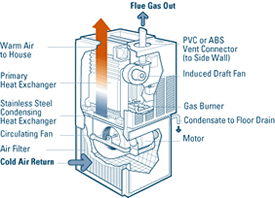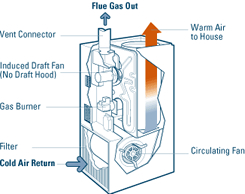
| A furnace is the most commonly known heating appliance in North America. Most modern "warm air" furnaces typically use a fan to circulate air to the rooms of a house and pull cooler air back to the furnace for reheating; this is called forced-air heat. Due to the fact that the fan easily overcomes the resistance of the ductwork, the arrangement of ducts can be far more flexible so that separate ducts can collect cool air to be returned to the furnace. One major advantage of this type of system is that it also enables easy installation of central air conditioning by simply adding a cooling coil at the supply air exhaust of the furnace. |
|


 With energy costs on the rise, heating your home during the winter months can be very costly if you have an inefficient furnace system. A high efficiency condensing gas furnace uses an average of 33 to 38 percent less energy than standard efficiency gas furnace systems. When compared to mid efficiency systems, the savings can be anywhere from 10 to 15 percent. Choosing a high efficiency gas furnace for your next installation or retrofit not only saves you money but reduces harmful environmental emissions that contribute to climate change. With energy costs on the rise, heating your home during the winter months can be very costly if you have an inefficient furnace system. A high efficiency condensing gas furnace uses an average of 33 to 38 percent less energy than standard efficiency gas furnace systems. When compared to mid efficiency systems, the savings can be anywhere from 10 to 15 percent. Choosing a high efficiency gas furnace for your next installation or retrofit not only saves you money but reduces harmful environmental emissions that contribute to climate change.
Condensing gas furnaces are the most energy-efficient furnaces available, with seasonal efficiencies between 89 and 97 percent. Most have burners similar to conventional furnaces, with draft supplied by an induced draft fan. There are additional heat exchange surfaces made of corrosion-resistant materials (usually stainless steel) that extract most of the heat remaining in the combustion by-products before they are exhausted. In this condensing heat exchange section, the combustion gases are cooled to a point where the water vapour condenses, thus releasing additional heat into the home. The condensate is piped to a floor drain.
|

 Mid-efficiency gas furnaces mainly use a naturally aspirating burner and do not have a continuously lit pilot light. They are equipped with a powered exhaust, usually with a built-in induced draft fan, and they do not have a draft hood. With more heat exchange, no dilution air, and high resistance to flow during the off cycle, seasonal efficiency is much higher for mid-efficiency gas furnaces than for conventional furnaces, offering energy savings of 23 to 28 percent over conventional gas furnaces. These systems can be vented through a properly sized chimney or out the side wall of the house using high-grade stainless steel. Mid-efficiency gas furnaces mainly use a naturally aspirating burner and do not have a continuously lit pilot light. They are equipped with a powered exhaust, usually with a built-in induced draft fan, and they do not have a draft hood. With more heat exchange, no dilution air, and high resistance to flow during the off cycle, seasonal efficiency is much higher for mid-efficiency gas furnaces than for conventional furnaces, offering energy savings of 23 to 28 percent over conventional gas furnaces. These systems can be vented through a properly sized chimney or out the side wall of the house using high-grade stainless steel. |
|